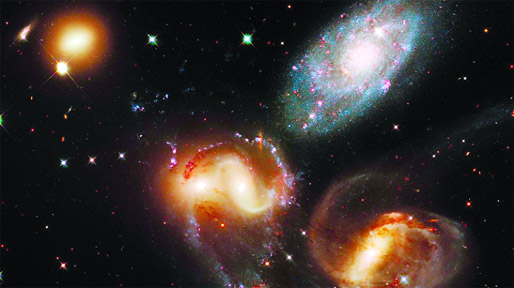
The Hubble Space Telescope has captured the picture of a galaxy with billions of stars, located 100 million light years away from the earth. The spiral galaxy, IC 4633, is located in the constellation Apus, Nasa said in a statement. “IC 4633 is a galaxy rich in star-forming activity and also hosts an active galactic nucleus at its core. From our point of view, the galaxy is tilted mostly towards us, giving astronomers a fairly good view of its billions of stars,” it said.
However, Nasa said that the galaxy’s features are partially obstructed due to a stretch of dark dust which covers the lower right of the picture. The cloud overlapping IC 4633 is a dark nebula, also known as MW9 and the South Celestial Serpent.
“This dark nebula is part of the Chamaeleon star-forming region, itself located only around 500 light-years from us, in a nearby part of our Milky Way galaxy,” it said.
The dark clouds in the Chamaeleon region occupy a large area of the southern sky, covering their constellation but also encroaching on nearby constellations, like the Apus.
“Classified as an integrated flux nebula (IFN) — a cloud of gas and dust in the Milky Way galaxy that’s not near to any single star and is only faintly lit by the total light of all the galaxy’s stars — this vast, narrow trail of faint gas that snakes over the southern celestial pole is much more subdued looking than its neighbors,” the space agency said.
The cloud is studied for its large amount of young stars, particularly the cloud Cha I, which has been captured by both the Hubble Telescope and the James Webb Space Telescope.
Earth’s mysterious twin Venus is leaking
Gases, including oxygen, are stripping away from the upper layers of the atmosphere of planet Venus, which is important to understand how the planet lost its water, a study said.
During its journey to Mercury in 2021, the joint European and Japanese mission BepiColombo performed its second fly-by of Venus and found that carbon and oxygen ions were escaping from the unexplored region of the planet’s magnetic environment, the study of which was published in Nature Astronomy journal. “These results have important implications regarding the evolution of Venus’s atmosphere and, in particular, the evolution of water on the surface of the planet,” the study stated. Over a period of 90 minutes, BepiColombo measured the number and mass of charged particles it encountered, capturing information about the chemical and physical processes driving atmospheric escape in the flank of the magnetosheath.
Venus doesn’t have an intrinsic magnetic field in its core like Earth. But, a weak, comet-shaped “induced magnetosphere” is created around the planet due to solar winds with electrically charged particles in Venus’s upper atmosphere. The region around the magnetosphere is called the “magnetosheath”, where the solar wind is slowed and heated.





Be the first to comment